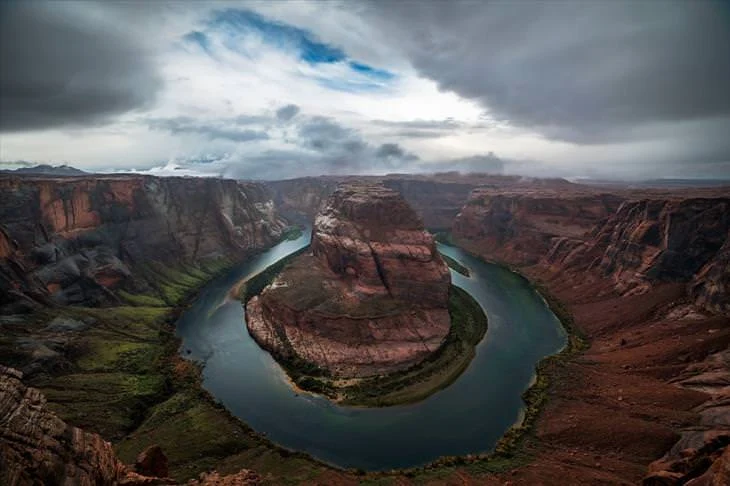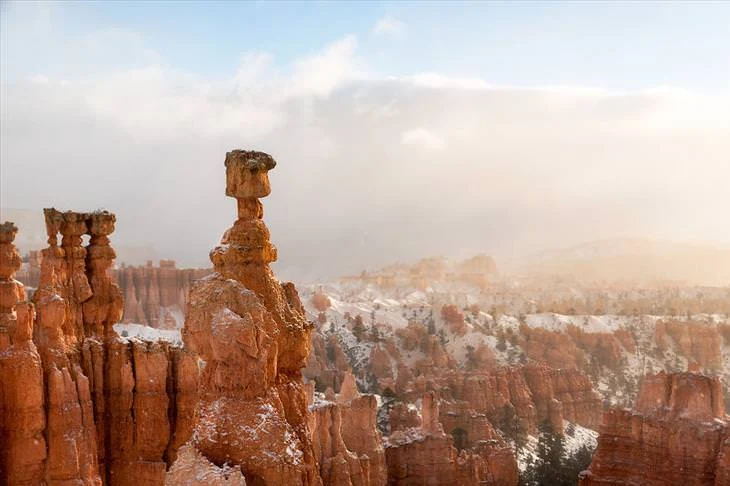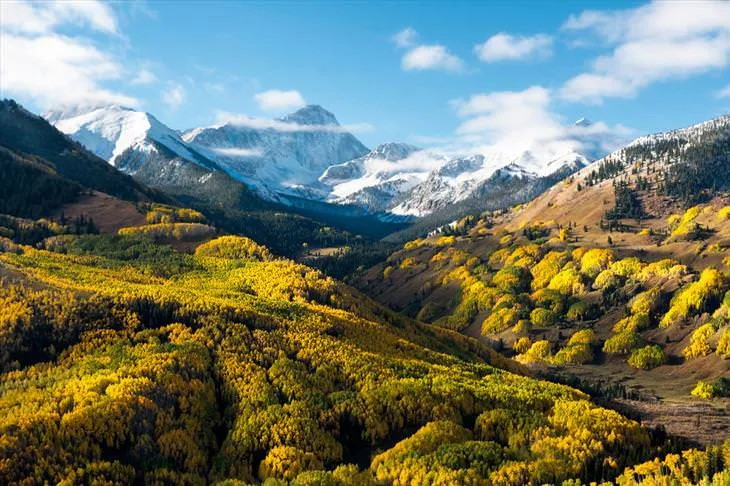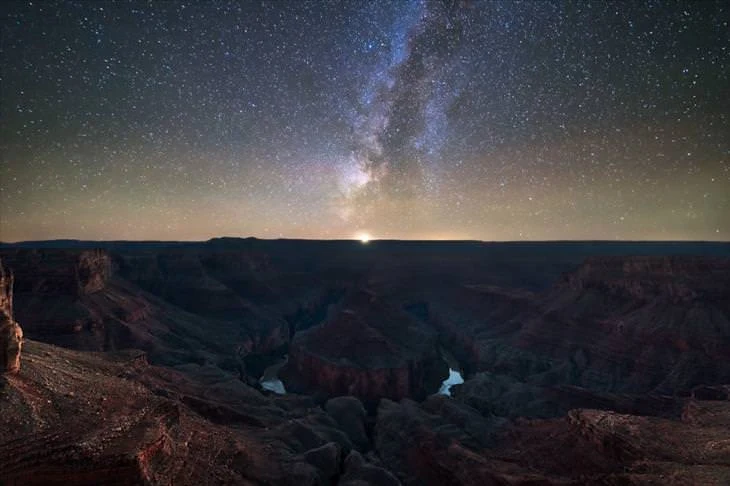Gaze in Wonder at These Amazing Photos of North America!
Thanks chiefly to the USA, it seems that every day the world's eyes are fixed on North America more than any other continent. Yet relatively little is said about the stunning natural beauty of the region, instead we focus on its economics, politics, and culture. Therefore, it is high time we celebrated the outstanding physical glories of North America, which we can do with these wonderful photos captured by Guido Diana during a recent photographic tour. Here are 35 of Guido's favourite pictures taken during a three-month trip that covered everywhere from the Canadian Rockies and the Golden Gate Bridge to the Grand Canyon and Statue of Liberty.
1. Cypress Tree Tunnel, California

This famous spot is found a mere hour away from San Francisco. The sunrise on a clear day will take your breath away.
2. Athabasca Falls, Canada
This location is a well-known spot for selfies. Yet, I must say, that I would never dare to step so close to the precipice, however beautiful it is.
3. Emerald Lake, Canada
Emerald Lake is so stunning it begs belief. I really wish I could live in that amazing lodge too!
4. Peyto Lake, Canada
Guido was camping during this trip. You can imagine how cold he felt this morning, yet he says the awesome view warmed his spirit up no end.
5. Antelope Canyon, Arizona
This celebrated lion-head formation once featured as a National Geographic front cover.
6. Courthouse Mountain, Colorado
Just gape in awe at how yellow those numerous aspen trees are during fall! This is one beautiful spot!
7. Glacier Point Yosemite, California
What a drop! And incredible scenery to boot.
8. Horseshoe Bend, Arizona
The horseshoe bend has never looked more menacing than here when a big storm threatened the famous American wonder.
9. Bow River, Canada
This train ride takes in some spellbinding Canadian scenery. A perfect journey for a weary and cold traveller.
10. Athabasca Glacier, Canada
The ice in this ice cave is so blue it's unreal!
11. The Subway, Utah
Guido had to climb rocks for five hours to reach this location, which he claims is one of the most amazing places he's ever seen.
12. Lake Louise, Canada
To get this perfect shot, Guido was forced to patiently wait for four days before the mist finally cleared.
13. Mount Sneffels, Colorado
For this sublime sunrise, Guido camped at the foot of the mountain for a good three days.
14. Last Dollar Road, Colorado
The Last Dollar Road is one of those places you have to be very lucky to actually go to see in person.
15. The Narrows, Utah
A waist-deep hike is said to be required to reach the Narrows. If you do so, bring the right clothing!
16. Mesa Arch, Utah
Though it looks serenely calm here, Guido was with around 20 other keen photographers, itching to capture a shot from this celebrated arch.
17. Patricia Lake, Canada
In this beautiful image, you can just about make out a pair of German fisherman venturing into the lake.
18. Bryce Canyon, Utah
Guido says that this photo was very troublesome to arrange due to ice-cold winds that rocked his tripod to and fro.
19. Capital Peak, Colorado
Those yellow aspen trees again. They add so much warmth to this extraordinary landscape.
20. Elk, Canada
I'd love to be lucky enough to come so close with such a beautiful native beast.
21. The Boss, Canada
This individual bear is said to have fathered 80% of all the cubs in the neighbourhood.
22. The Golden Gate Bridge, California
No tour of America would be complete without driving over, and stepping back to appreciate, this modern man-made wonder.
23. Secret Canyon, Arizona
This bend is even larger than the Horseshoe Bend. At night the stars light it up magnificently.
24. The Subway, Utah
From this angle, it's even clearer why the Subway reminds so many people of a natural (and much more beautiful) equivalent of the modern transport system.
25. Manhattan, New York City
On Guido's first day in America, September 11th, 2016, he was present to witness a touching yet defiant light beam tribute to the city's fallen victims of 2001.
26. Mount Sneffels, Colorado
This image is a composite of 100-star pictures.
27. Pyramid Mountain, Canada
Jasper National Park is one of many incredible parks found in the gorgeous nation of Canada.
28. San Juan Mountain Range, Colorado
During sunrise one morning, Guido was blown away by the colourful landscape that surrounded him in Colorado.
29. Mobius Arch, California
The bright lights of LA seem a million miles away beneath Mobius Arch. All the better to see such a splendid night sky.
30. Maroon Bells, Colorado
A true fairytale scene can be found here in Maroon Bells. Guido says that he was far from alone though, with 150 photographers for company.
31. Patricia Lake, Canada
When the world is this beautiful, it knows the best thing it can do is duplicate itself.
32. Statue of Liberty, New York City
This location is a well-known spot for selfies. Yet, I must say, that I would never dare to step so close to the precipice, however beautiful it is.
3. Emerald Lake, Canada
Emerald Lake is so stunning it begs belief. I really wish I could live in that amazing lodge too!
4. Peyto Lake, Canada
Guido was camping during this trip. You can imagine how cold he felt this morning, yet he says the awesome view warmed his spirit up no end.
5. Antelope Canyon, Arizona
This celebrated lion-head formation once featured as a National Geographic front cover.
6. Courthouse Mountain, Colorado
Just gape in awe at how yellow those numerous aspen trees are during fall! This is one beautiful spot!
7. Glacier Point Yosemite, California
What a drop! And incredible scenery to boot.
8. Horseshoe Bend, Arizona
The horseshoe bend has never looked more menacing than here when a big storm threatened the famous American wonder.
9. Bow River, Canada
This train ride takes in some spellbinding Canadian scenery. A perfect journey for a weary and cold traveller.
10. Athabasca Glacier, Canada
The ice in this ice cave is so blue it's unreal!
11. The Subway, Utah
Guido had to climb rocks for five hours to reach this location, which he claims is one of the most amazing places he's ever seen.
12. Lake Louise, Canada
To get this perfect shot, Guido was forced to patiently wait for four days before the mist finally cleared.
13. Mount Sneffels, Colorado
For this sublime sunrise, Guido camped at the foot of the mountain for a good three days.
14. Last Dollar Road, Colorado
The Last Dollar Road is one of those places you have to be very lucky to actually go to see in person.
15. The Narrows, Utah
A waist-deep hike is said to be required to reach the Narrows. If you do so, bring the right clothing!
16. Mesa Arch, Utah
Though it looks serenely calm here, Guido was with around 20 other keen photographers, itching to capture a shot from this celebrated arch.
17. Patricia Lake, Canada
In this beautiful image, you can just about make out a pair of German fisherman venturing into the lake.
18. Bryce Canyon, Utah
Guido says that this photo was very troublesome to arrange due to ice-cold winds that rocked his tripod to and fro.
19. Capital Peak, Colorado
Those yellow aspen trees again. They add so much warmth to this extraordinary landscape.
20. Elk, Canada
I'd love to be lucky enough to come so close with such a beautiful native beast.
21. The Boss, Canada
This individual bear is said to have fathered 80% of all the cubs in the neighbourhood.
22. The Golden Gate Bridge, California
No tour of America would be complete without driving over, and stepping back to appreciate, this modern man-made wonder.
23. Secret Canyon, Arizona
This bend is even larger than the Horseshoe Bend. At night the stars light it up magnificently.
24. The Subway, Utah
From this angle, it's even clearer why the Subway reminds so many people of a natural (and much more beautiful) equivalent of the modern transport system.
25. Manhattan, New York City
On Guido's first day in America, September 11th, 2016, he was present to witness a touching yet defiant light beam tribute to the city's fallen victims of 2001.
26. Mount Sneffels, Colorado
This image is a composite of 100-star pictures.
27. Pyramid Mountain, Canada
Jasper National Park is one of many incredible parks found in the gorgeous nation of Canada.
28. San Juan Mountain Range, Colorado
During sunrise one morning, Guido was blown away by the colourful landscape that surrounded him in Colorado.
29. Mobius Arch, California
The bright lights of LA seem a million miles away beneath Mobius Arch. All the better to see such a splendid night sky.
30. Maroon Bells, Colorado
A true fairytale scene can be found here in Maroon Bells. Guido says that he was far from alone though, with 150 photographers for company.
31. Patricia Lake, Canada
When the world is this beautiful, it knows the best thing it can do is duplicate itself.
32. Statue of Liberty, New York City









































































